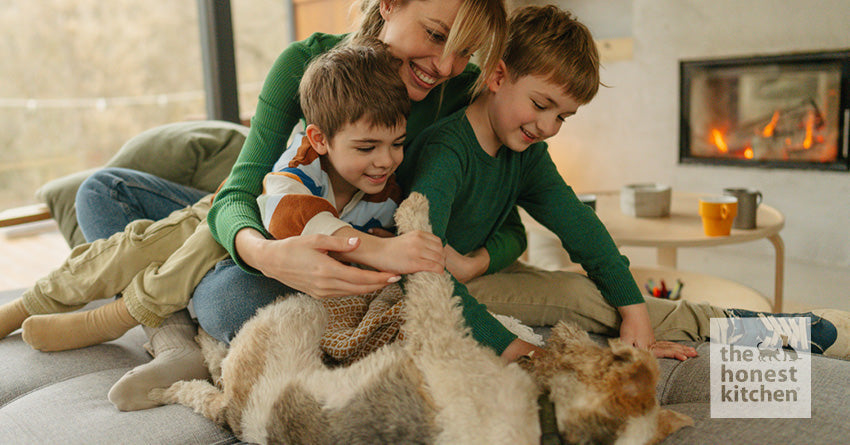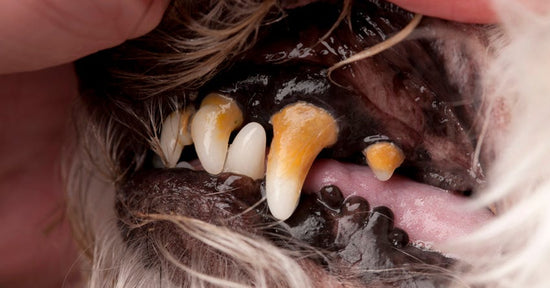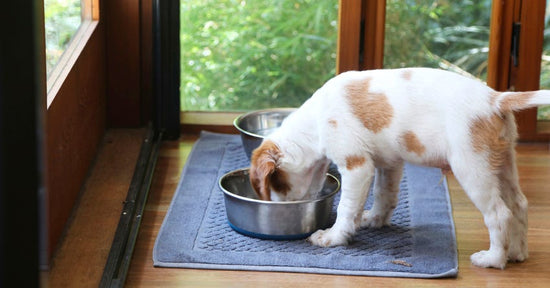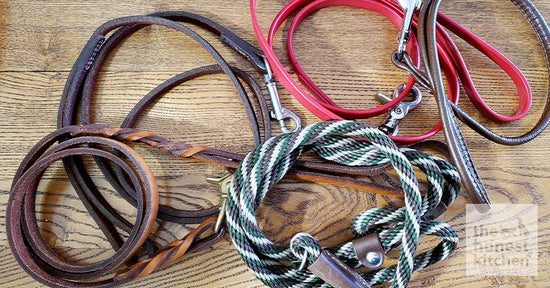The Ultimate Checklist for First-Time Dog Owners

Have you decided to become a dog parent? If so, you’ve likely put a lot of planning and thought into this important decision, and now you’re ready to dive into the details of dog ownership.
That’s why we’ve put together this comprehensive checklist to help prepare first-time dog owners like you.
Below, we’ll cover questions to ask before taking your pup home, what supplies you’ll need for your new dog, how to choose food to support their longevity, and more.
What To Ask Before Getting a Dog for the First Time
Before adopting a dog, it’s important to ask questions to fully understand what you’re getting into — especially if the dog has any health or age-related concerns.
Here are some questions we recommend asking:
Has the dog received flea and tick preventatives?
What vaccinations, dewormings, and veterinary care has the dog received, and what does the dog still need? What was the date of this care?
What is the dog currently eating?
How old is the dog? (Note: Older dogs may have more complex needs than younger dogs.)
Has the dog been spayed or neutered?
Are there any illnesses in the shelter or breeder environment I should be aware of?
Has the dog been ill, or are they currently exhibiting symptoms of illness?
Does the dog have any behavioral issues? Are there any people or other animals the dog shows signs of aggression toward?
1. Prepare Your Home
Safety Proofing
Follow these steps to help eliminate common household hazards and puppy-proof your home.
Ensure there are no electric cords or open outlets at the dog’s level.
Make sure there are no small objects a dog could ingest and/or choke on, such as rocks, Legos, or other tiny objects.
Purchase baby gates to keep your dog out of areas they shouldn’t be in.
Secure trash cans.
Remove toxic plants from your home or yard.
If you have an unfenced yard, consider installing a physical or invisible fence. Otherwise, it’s important to keep your dog on a leash anytime they’re outside.
Keep cleaning supplies, toxic chemicals, and medications inside cabinets or closets, away from a dog’s reach.
Keep the toilet seat down to prevent your pup from drinking from it or falling in.
Getting Essential Supplies For a New Puppy or Dog
Once your home is secure and safe for your new dog, you’ll need to get some supplies to support them. Here is a list of some must-have and nice-to-have items for your pup.
Dog collar: Pet collars are extremely important, even when your pet will stay mainly indoors, as accidents can happen. If you plan to keep the collar on at all times, consider one that can break away to reduce the risk of choking or strangulation.
Leash: There are many choices when it comes to dog leashes, so it’s important to consider your dog’s size, activity level, and style to choose the best leash for them.
ID tag: The ID tag should at least contain your dog’s name and your phone number. But you can also include a QR code with more details like your address, email, and additional information about your pup. Beyond an ID tag, it’s highly recommended to microchip your dog (some shelters do this for you). If you opt for a microchip, be sure to keep your information up to date.
Food and water: Ideally, you’ll want to get the same food your dog has been eating and then gradually transition them to something else, if needed.
Bowls/dishes: Believe it or not, the water and food bowls you choose for your pup matter. Different materials hold up better than others — stainless steel is often the best. You should also consider different bowl shapes and heights to ensure your dog has the best bowls for their size and needs.
Dog bed: It’s vital to offer your new pup a place that is just theirs, so choose a dog bed that is comfortable for your pet and made with a durable, washable material.
Flea and tick prevention: Fleas and ticks are two of the most frequent pet care concerns in the U.S., due to their impact on both pets and humans. So make sure you treat your new pup regularly with vet-prescribed treatments.
Dog crates: Crates aren’t necessary for all dogs, but a crate can be a helpful tool when dog training. Some dogs grow accustomed to having their own space to retreat to.
Nail clippers: Clipping your dog’s nails at home is a good habit to get into, along with ear cleaning.
Shampoo: Bathing frequency will largely depend on fur length and texture. Surprisingly, short-coat or hairless dogs require more frequent bathing than long-coat dogs.
Brush: Brushing frequency also depends on your dog’s coat, as well as the time of year (dogs typically shed more in the spring and summer).
De-matting comb for dogs with long hair: If your pup has long hair, seek out a de-matting comb to ensure your dog’s comfort when brushing.
Toothbrush and toothpaste: Annual dental cleanings at the vet are important, but you should brush their teeth regularly at home as well. This can be a tough habit to establish, but one a dog can learn to enjoy.
Dog chew toys, Kong toys, enrichment items: Play time will be a great way to bond with your new pup, so be sure you have toys for both joint and independent play.
Creating Sleeping and Eating Areas
2. Focus on Health and Nutrition
Choosing the Ideal Dog Food
As mentioned, when you adopt your pup, you’ll want to keep feeding them the same food they’re used to in order to avoid any stomach upset. But you can slowly transition them to a new food over a few weeks.
There’s a lot to consider when choosing the right food for your new pup — you’ll want to think about your dog’s age, size, nutritional needs, and preferences when choosing a new dog food. For example, a growing puppy has very different nutritional requirements than a sedentary senior dog.
If you’re looking for high-quality options, The Honest Kitchen offers whole grain and grain free puppy food options formulated to support puppies’ specific needs, as well as several recipes that meet the needs of seniors.
Understanding Regular Health Requirements
You’ll also need to understand your dog’s health requirements, including:
Veterinary care: It’s a good idea to establish a veterinarian before adopting a dog to ensure they have room for new patients. If you’re adopting from a shelter or working with a breeder, they may have a recommended vet. Depending on your dog’s history, you may need to get them in for a vet appointment right away.
Essential vaccinations: It’s important to schedule regular veterinary check-ups to ensure your dog is healthy and receiving necessary vaccinations. Common core vaccinations include canine parvovirus, canine distemper, hepatitis, and rabies. Non-core vaccines include Bordetella, canine influenza, leptospirosis, and the Lyme vaccine.
Spaying and neutering: Fixing your dog can be beneficial for their long-term health. Beyond preventing pregnancy, spaying can help prevent uterine infection and reduce the risk of breast cancer in female dogs. And neutering can reduce the risk of testicular cancer and developing enlarged prostate glands in male dogs.
Preventing Parasites and Other Infections
Finally, preventing parasites like fleas, ticks, and worms is important for any pet parent. Here are some prevention tips to tap into from the American Kennel Club:
Only use veterinary-approved flea and tick products.
Regularly inspect your dog (even if they’re taking preventative products) after spending time in the woods or grassy settings.
Keep your grass mowed as short as possible.
Invest in an outdoor dog bed so your pup can relax outside off the ground.
If you see a tick, remove it as soon as possible. The quicker you remove it, the less likely your dog will contract a secondary illness.
3. Train and Socialize Your New Family Member
Teaching Basic Commands
Training your dog to follow basic commands can be a great place to start — and you may never need to go beyond that. Some of the basics include sit, stay, come, lie down, watch me, heel, leave it, go to a specific spot, and take it/drop it.
You can train your dog using high-quality training treats or dry food, such as The Honest Kitchen’s Dry Dog Food Clusters. Just make sure you’re not adding too many extra calories to your dog’s diet.
If you’re not sure where to start, talk to the shelter you’re adopting your pup from for dog trainer recommendations or look to your local pet store, as many hold training classes.
House Training
House training may be necessary for dogs of any age, but puppies especially need potty training. One of the best ways to approach house training is to establish a routine from the first day they arrive home and support that routine with positive reinforcement.
Positive reinforcement could look like giving your dog a small treat or belly rubs when they go to the bathroom outside or on their puppy pad. Just remember that accidents will happen, and it’s important not to punish your dog for having one.
Learning About New Environments, People, and Animals
Early socialization is another important aspect when welcoming a new dog home. You’ll want to introduce them to various environments, animals, and people. There is a fine line, though, between getting your pup acclimated to the environment and overstimulating them, so go slow.
You can start by connecting with other pet owners you know for advice, support, and socialization opportunities. Another avenue is to slowly introduce them to other people who are often at your home. But proceed with caution when introducing dogs to children, especially if they’ve never been around kids before.
4. Practice Daily Care and Pet Maintenance
Understanding Your Dog’s Needs
It’s important to develop a solid understanding of your dog’s baseline when it comes to health, behavior, and happiness. This will make it much easier to identify when they’re struggling or something is off.
And if you sense something is wrong with your dog, trust your instincts and make an appointment with the vet. Even if it turns out to be nothing, it’s better to be safe.
Grooming and Hygiene
Grooming (either at home or at a professional groomer) should happen regularly so your pup can get used to it. Ideally, regular grooming will include brushing, bathing, nail trimming, and teeth cleaning.
Grooming frequency will depend on the type of dog you have, their lifestyle, and their individual health, but a good place to start is once per month. Then you can adjust as you see fit.
Identifying and Addressing Behavioral Issues
It's vital to recognize and address behavioral problems as soon as they come up. Sometimes a behavioral issue will pop up out of seemingly nowhere and require some investigation on your part. The key to identifying and addressing behavior issues is to have patience and stay consistent.
Keep in mind that there can be medical causes for behavioral issues, so it’s a good idea to talk to your vet about any sudden changes in behavior.
Embrace the New Dog in Your Life with The Honest Kitchen
Bringing home your new best friend is such an exciting time and can exponentially improve the quality of your life — and that of your furry friend. There’s a lot you’ll need to consider when adding a dog to the family, but what’s really at the core of it all is approaching dog ownership with patience, love, and commitment.
And if you’re looking for a new dog food to support your dog’s overall health and longevity, check out The Honest Kitchen. With human grade wet dog food, healthy kibble-alternative dry dog food, tasty treats, and more, The Honest Kitchen has something to fit every dog’s needs and tastes.
Check out all of The Honest Kitchen’s offerings to find the perfect food for your new pup!





